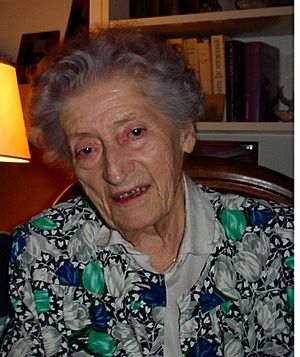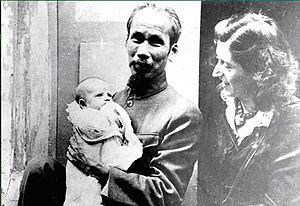Lucie Aubrac facts for kids
Quick facts for kids
Lucie Aubrac
|
|
|---|---|

Lucie Aubrac in 2003
|
|
| Born |
Lucie Bernard
29 June 1912 |
| Died | 14 March 2007 (aged 94) Issy-les-Moulineaux, Paris, France
|
| Nationality | French |
| Occupation | member of French Resistance, history teacher |
| Spouse(s) | Raymond Aubrac (1939–2007; her death) |
| Children | 3 |
Lucie Samuel (born Lucie Bernard, June 29, 1912 – March 14, 2007) was a brave French history teacher. She is best known as Lucie Aubrac. During World War II, she was a very important member of the French Resistance. This was a secret group that fought against the Nazi occupation of France. In 1938, she became a history teacher, which was quite rare for women back then. In 1939, she married Raymond Samuel, who later became known as Raymond Aubrac.
Contents
Fighting for Freedom
In 1940, Lucie was one of the first people to join the French Resistance. In Clermont-Ferrand, she and her husband, Raymond, helped form a Resistance group. This group was first called La Dernière Colonne. Later, it became known as Libération-sud.
In 1941, the group carried out two secret attacks. They sabotaged train stations in Perpignan and Cannes. In February, they printed and shared 10,000 flyers. These flyers spread messages against the occupation. After this, Lucie gave birth to her first child. The group then decided to go into hiding for a while.
After a few months, they started a secret newspaper called Libération. The first edition was put together with help from local printers. They used paper given by trade union members. In July 1941, 10,000 copies of the newspaper were printed.
Daring Rescues
In March 1943, Raymond was arrested. Lucie bravely went to the local prosecutor. She told him that if Raymond was not released, he would be killed. Raymond was freed in May. After this, Lucie and Raymond helped three other members of their group escape.
A month later, Raymond was arrested again. This time, he was caught by the Gestapo. This was the secret police of Nazi Germany. Lucie went to see Klaus Barbie, a well-known Gestapo chief. She pretended to be Raymond's fiancée. She claimed his name was "Ermelin" and that he was innocent. She said he had just been visiting a doctor when he was caught.
Lucie was told Raymond would be executed. But she managed to get permission to marry him first. She said she wanted to save her honor and make sure her unborn child was legitimate. When Raymond was being taken back to prison after this "wedding," Lucie led a commando unit. They attacked the vehicle he was in. They rescued Raymond and fifteen other prisoners. Six guards were killed during this daring rescue.
After the War

In 1944, Charles de Gaulle set up a special assembly. Lucie joined it as a representative for the Resistance. This made her the first woman to be part of a French parliamentary assembly. In 1945, she wrote the first short history of the French Resistance.
In 1946, Lucie and Raymond hosted Ho Chi Minh at their home. He was visiting France to try and win independence for Vietnam. Vietnam was a French colony at the time. Ho Chi Minh and Raymond became good friends.
In 1984, Lucie published a book about her wartime experiences. It was called Outwitting the Gestapo in English. She decided to write her story after Klaus Barbie claimed Raymond had betrayed a Resistance leader named Jean Moulin.
In 1996, the French government honored Lucie. She received the Legion of Honor for her bravery in World War II. A 1997 film called Lucie Aubrac was made about her. It showed her efforts to rescue her husband. Lucie herself supported the film.
Clearing Their Names
In 1997, some people tried to say that the Aubracs had betrayed Jean Moulin. A lawyer named Jacques Vergès claimed Klaus Barbie had given him a document. This document supposedly showed the Aubracs had told Barbie about Moulin. A book also tried to prove this.
But in 1998, a court in Paris fined the author and publisher of the book. They were found guilty of "public defamation." This meant they had unfairly damaged the Aubracs' reputation. Many leading Resistance survivors also spoke out. They wrote a letter protesting the accusations against Lucie and Raymond. The Aubracs even met with historians to discuss the matter. The historians did not believe Raymond was a traitor. However, they did notice some small differences in Lucie's story.
Some later books still suggested Raymond, and possibly Lucie, might have betrayed Moulin. But these claims were not supported by strong evidence.
Family and Legacy
Lucie and Raymond had three children together. Charles de Gaulle was the godfather to their second child, Catherine. Ho Chi Minh was the godfather to their third child, Elizabeth.
After Raymond's death in 2012, President Nicolas Sarkozy spoke about him. He said Raymond's escape, led by Lucie in 1943, had "become a legend." He praised Raymond and all Resistance members as "heroes." François Hollande also said that Raymond, with Lucie, was among "the righteous." They found the strength to fight against Nazi cruelty.
Lucie's ashes are buried next to Raymond's. Their family tomb is in the cemetery in the village of Salornay-sur-Guye.
Images for kids
-
Ho Chi Minh, baby Elizabeth Aubrac and Lucie Aubrac, 1946
See also
 In Spanish: Lucie Aubrac para niños
In Spanish: Lucie Aubrac para niños




